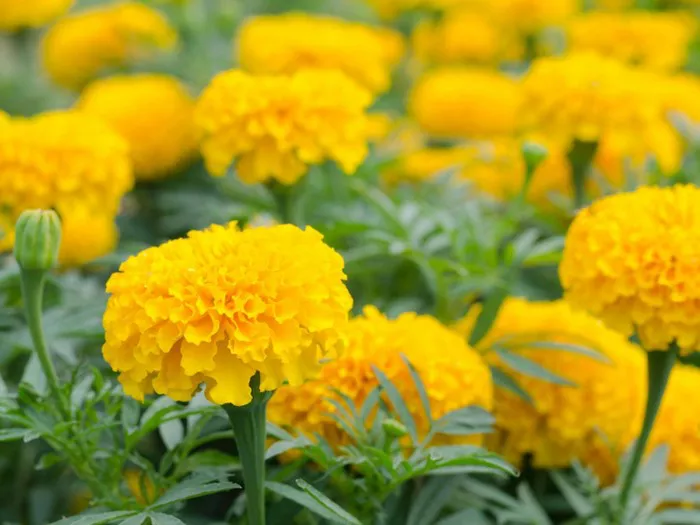Marigolds, with their vibrant hues and delicate petals, are a popular choice for gardens, borders, and containers around the world. Their cheerful appearance and low maintenance requirements make them a favorite among gardeners of all skill levels. However, one question that often arises among those cultivating marigolds is: how long does it take for these beautiful blooms to appear? In this article, we delve into the intricacies of marigold growth and development to provide a comprehensive answer to this query.
The Germination Stage:
The journey of a marigold plant begins with germination, the process by which a seed sprouts and begins to grow. Marigold seeds typically germinate relatively quickly, often within 4 to 14 days after sowing, depending on various factors such as temperature, moisture, and seed quality. In optimal conditions, with adequate moisture and warmth, germination can occur on the shorter end of this spectrum. However, cooler temperatures or improper watering practices may prolong the germination period.
Seedling Growth and Development:
Following germination, marigold seedlings emerge from the soil, initially displaying a pair of cotyledon leaves. These embryonic leaves provide the seedling with essential nutrients until true leaves develop. Over the next few weeks, the seedling undergoes rapid growth as it establishes a robust root system and produces additional leaves. Under optimal conditions, marigold seedlings typically reach a height of 2 to 4 inches within 3 to 4 weeks after germination.
Formation of Flower Buds:
As marigold plants continue to grow and mature, they eventually transition from vegetative growth to reproductive growth, marked by the formation of flower buds. The timing of bud formation varies depending on factors such as day length, temperature, and cultivar. In general, most varieties of marigolds begin to produce flower buds approximately 8 to 10 weeks after germination.
Blooming Period:
Once the flower buds have formed, it is only a matter of time before they burst into full bloom, adorning the plant with their vibrant colors and distinctive aroma. The duration of the blooming period can vary significantly depending on the specific cultivar, environmental conditions, and cultural practices. However, in general, marigold flowers typically remain in bloom for several weeks to months, providing a long-lasting display of beauty in the garden.
Factors Affecting Flowering Time:
While the aforementioned timeline provides a general overview of the flowering process in marigolds, it is essential to recognize that various factors can influence the timing of bloom initiation and duration. Some of the key factors to consider include:
Temperature: Marigolds thrive in warm temperatures and require adequate heat to initiate flowering. Cooler temperatures may delay the onset of blooming, while excessive heat can cause flowers to wilt prematurely.
Day Length: Marigolds are photoperiodic plants, meaning their flowering is influenced by the length of daylight. Longer days typically promote flower initiation, while shorter days may delay blooming.
Soil Moisture and Nutrition: Proper soil moisture and nutrient levels are essential for healthy plant growth and flowering. Inadequate water or nutrient deficiencies can impede flower development and reduce bloom quality.
Cultivar Differences: Different marigold cultivars exhibit varying growth habits, flower colors, and flowering times. Some cultivars may bloom earlier or later than others, so it is essential to select varieties suited to your specific growing conditions and preferences.
Tips for Promoting Healthy Flowering:
To maximize the blooming potential of your marigold plants, consider implementing the following tips:
Provide Adequate Sunlight: Marigolds thrive in full sunlight and require at least 6 to 8 hours of direct sunlight per day for optimal growth and flowering.
Ensure Proper Watering: Consistent moisture is essential for healthy marigold plants. Water deeply and regularly, especially during periods of hot weather or drought, but avoid overwatering, which can lead to root rot.
Fertilize Appropriately: Apply a balanced fertilizer formulated for flowering plants to provide essential nutrients for robust growth and abundant blooms. Follow the manufacturer’s recommendations for application rates and frequency.
Deadhead Spent Flowers: Remove faded or spent flowers regularly to encourage continuous blooming and prevent the plant from directing energy into seed production.
Monitor for Pests and Diseases: Keep an eye out for common pests such as aphids, spider mites, and whiteflies, as well as diseases like powdery mildew and root rot. Promptly address any issues to prevent damage to the plant and inhibit flowering.
Conclusion
In conclusion, the timing of flowering in marigolds is influenced by a combination of genetic, environmental, and cultural factors. From germination to blooming, each stage of the plant’s life cycle plays a crucial role in determining when and how prolifically it will flower. By understanding these factors and providing optimal growing conditions, gardeners can ensure that their marigold plants bloom profusely, adding a splash of color and fragrance to the garden throughout the growing season.


